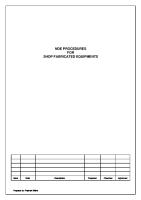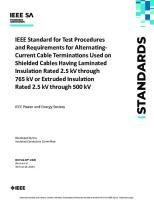4.8 Bunker Line Test Procedure [PDF]
4.8 BUNKER LINE TEST PROCEDURE Technical and Maintenance Manual 01-Aug-2020 Rev 2 Page 1 of 2 Purpose To outline pro
36 0 105KB
Papiere empfehlen
![4.8 Bunker Line Test Procedure [PDF]](https://vdoc.tips/img/200x200/48-bunker-line-test-procedure.jpg)
- Author / Uploaded
- Gouri
Datei wird geladen, bitte warten...
Zitiervorschau
4.8 BUNKER LINE TEST PROCEDURE Technical and Maintenance Manual
01-Aug-2020
Rev 2
Page 1 of 2
Purpose To outline procedures for testing vessel bunker lines.
4.8.1
Responsibility A responsible ship’s engineer under Chief Engineer’s supervision should carry out the test.
4.8.2
Frequency of Tests Frequency Test Pressure Test Medium 12 Monthly 100 % MAWP* Hydrostatic After any major repairs 100 % MAWP Hydrostatic Twice within any 5-year Period 150 % MAWP Hydrostatic 1. Maintain records in vessel’s PMS and the certificate for hydrostatic pressure test on board. 2. Display MAWP, test pressure and testing date of lines in Engine control room and on lines. 3. Chief Engineer must supervise the testing operation. * MAWP = Maximum Allowable Working Pressure.
Note 1 When determining MAWP, consider service ratings of the valves and seat rings. Confirm MAWP from the piping diagram provided by yard.
Caution Do not exceed the Maximum Allowable Working Pressure (MAWP) of the bunker system, when in use.
4.8.3
Hydrostatic Testing Procedures Prior pressure testing:
Carry out a risk assessment and toolbox meeting Plug all scuppers on deck. Keep SOPEP and firefighting equipment ready Drain all bunker lines into bunker tanks Blank the manifolds using new gaskets and blank flanges (of same thickness or certified rating as that of pipeline). Fit calibrated pressure gauges (with valves) at outboard end of manifold Line up the system as required. Shut all tank filling and drain valves. Open bunker manifold valve When carrying out bunker testing:
Fill up the bunker line with fuel oil using transfer pump. Only keep the filling valve of that tank open from which suction is being taken. When the pressure reaches 0.5 kg/cm2 stop the transfer pump. Confirm piping system is full of liquid and free from airlocks.
Connect portable pressure pump to manifold line connection. Use Diesel oil as medium.
4.8 BUNKER LINE TEST PROCEDURE Technical and Maintenance Manual
01-Aug-2020
Rev 2
Page 2 of 2
Pressurise the bunker line initially to 2 kg/cm2 and check for leaks. Gradually increase to the required pressure (not exceeding MAWP) after confirming there are no leaks. Hold the test pressure for 30 minutes. Inspect all exposed section of the pipeline, particularly the flanges, valves and expansion couplings. In the case of any defects during the test, rectify and retest the pipeline. Drain all lines immediately after the test and close the associated valves. Carry out the bunker line pressure testing as per vessel-specific work instruction. Additionally, on Tankers and Gas Carriers, comply with Company provided OPS form
Note 2 Confirm the MAWP from the piping diagram provided by yard. Do not raise pressure more than required.
Caution Keep staff standby with walkie-talkies, near manifolds and along bunker lines / valves for reporting pressures and any leaks. Forms and checklists:
References:
CL: RA: WI: E/139 FORM: OPS/TNKR/29, OPS/CHEM/27, OPS/GAS/24, OPS/LNG/24
Training Material #08









